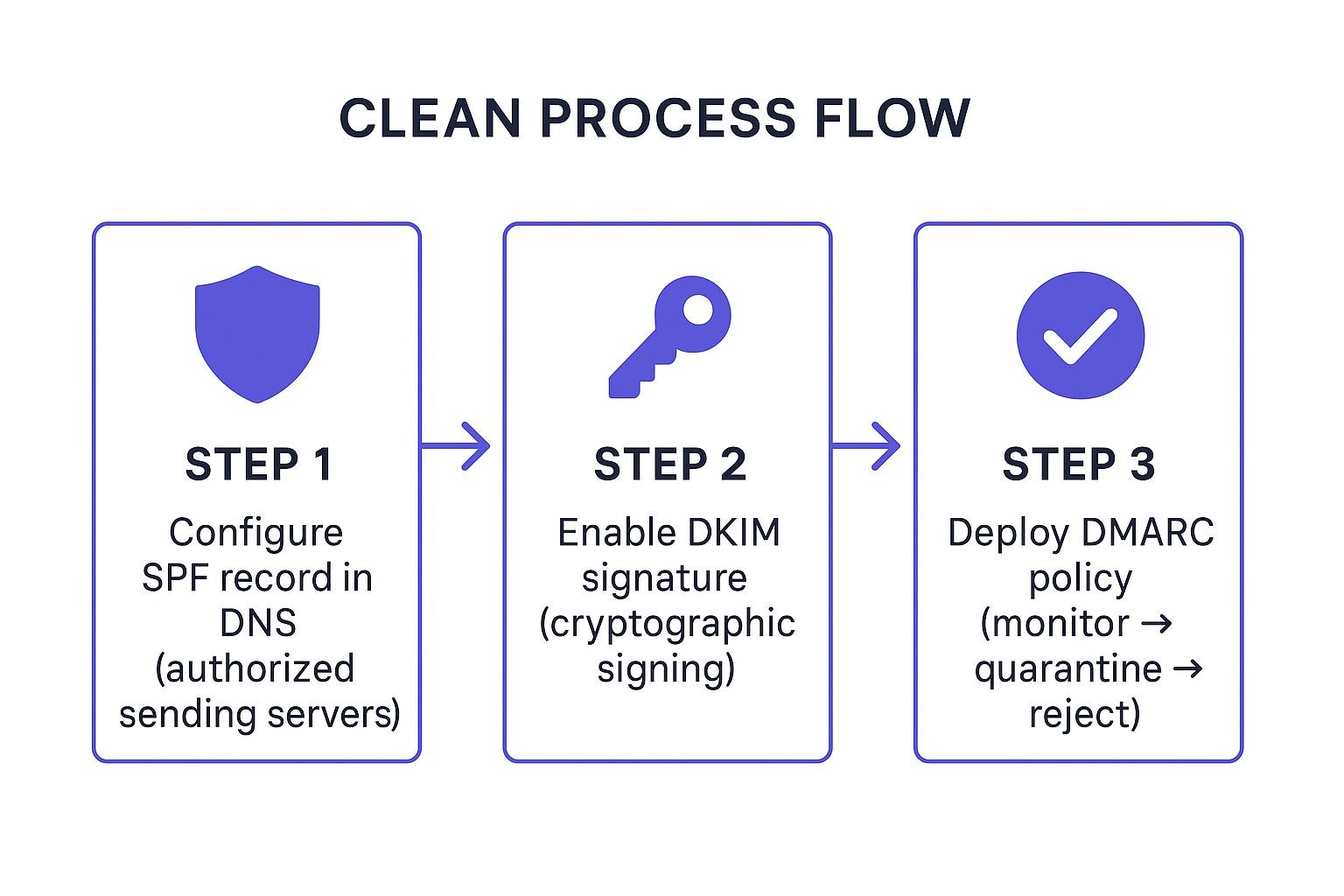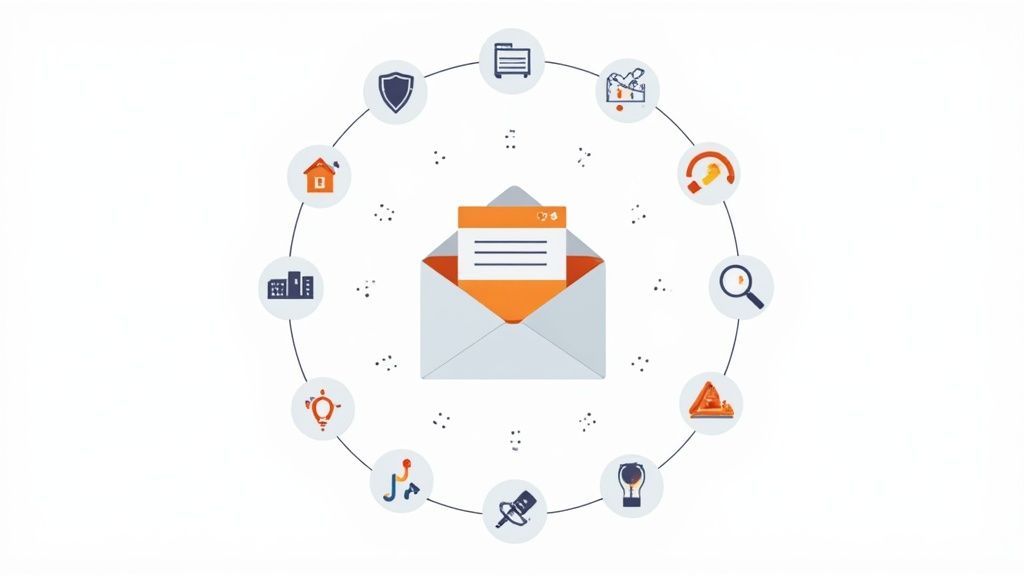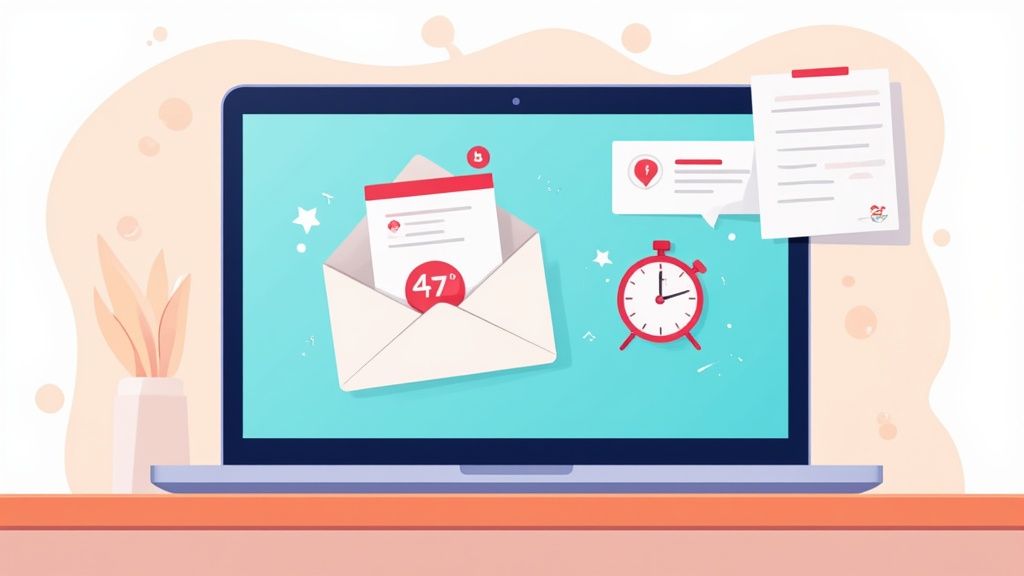Email remains the cornerstone of digital communication, but simply hitting 'send' no longer guarantees your message will be seen. With major providers like Gmail and Yahoo tightening their bulk sender requirements in 2024, understanding the intricate dance of email deliverability has become non-negotiable for marketers, event organizers, and businesses of all sizes. The stakes are higher than ever; poor deliverability doesn't just mean a lower open rate, it can actively damage your sender reputation, waste your marketing budget, and disconnect you from your most engaged audience members.
This guide cuts through the noise to provide a comprehensive roundup of the most critical, actionable email deliverability best practices. We'll move beyond the basics, offering detailed implementation steps and fresh perspectives to ensure your carefully crafted messages consistently land in the inbox, not the spam folder. Whether you're sending event invitations, promotional campaigns, or webinar reminders, the principles here are fundamental to your success.
In this listicle, you will learn how to:
- Correctly configure technical authentication like SPF, DKIM, and DMARC.
- Implement strict list hygiene to maintain a high-quality subscriber base.
- Actively build and protect your sender reputation with ISPs.
- Optimize your content to avoid spam triggers and improve engagement.
Mastering these strategies is the key to building trust with both subscribers and Internet Service Providers (ISPs). By implementing these email deliverability best practices, you ensure your communication channel remains powerful, effective, and capable of driving real results for your business or event.
1. Implement Proper Email Authentication (SPF, DKIM, DMARC)
Think of email authentication as the digital passport for your domain. It proves to inbox providers like Gmail and Outlook that your emails are legitimate and not sent by a malicious actor impersonating you. Implementing these protocols is a foundational step in any serious email deliverability strategy, directly impacting whether your messages are trusted or flagged as suspicious.
The three core protocols work together to build a powerful defense:
- SPF (Sender Policy Framework): This is a DNS text record that lists all the mail servers authorized to send email on behalf of your domain. It’s like creating an approved sender list.
- DKIM (DomainKeys Identified Mail): This adds a tamper-proof digital signature to your emails. The receiving server uses a public key in your DNS to verify that the message hasn't been altered in transit.
- DMARC (Domain-based Message Authentication, Reporting & Conformance): This protocol builds on SPF and DKIM. It tells receiving servers what to do if an email fails authentication checks (e.g., quarantine or reject it) and provides valuable reports on your email activity.
The Phased Approach to Full Authentication
Implementing all three protocols correctly can seem daunting, but a phased approach simplifies the process and minimizes risk. This ensures you gather data and make adjustments before enforcing strict policies that could block legitimate mail.
The infographic below illustrates the recommended three-step flow for deploying robust email authentication.

Following this sequence allows you to build a secure foundation with SPF and DKIM before using DMARC to monitor and enforce your sending policies.
Actionable Tips for Implementation
To get started, focus on these practical steps:
- Start with a 'none' policy: When first setting up DMARC, use the
p=nonetag. This "monitoring mode" allows you to receive reports on authentication failures without affecting email delivery. - Use DMARC analyzers: Tools like DMARC Analyzer or EasyDMARC help you interpret the complex reports, making it easier to identify unauthorized senders and fix configuration issues.
- Gradually increase enforcement: Once you are confident that all your legitimate sending services are properly authenticated, you can slowly transition your DMARC policy from
p=nonetop=quarantineand finally top=rejectfor maximum protection. This methodical approach is one of the most critical email deliverability best practices for preventing accidental blocking of your own emails.
2. Maintain Clean Email Lists and Regular List Hygiene
Think of your email list as a garden; without regular weeding, it becomes overgrown with inactive and invalid contacts that stifle growth. List hygiene is the crucial practice of regularly cleaning your subscriber lists by removing problematic email addresses. This process directly tells inbox providers that you are a responsible sender who respects recipient inboxes, which is fundamental to achieving high deliverability.
Sending emails to invalid addresses or disengaged subscribers results in high bounce rates and low engagement, which are strong negative signals to ISPs like Gmail and Outlook. These signals damage your sender reputation, making it harder for your emails to reach even your most active subscribers. Regularly cleaning your list is one of the most effective email deliverability best practices for maintaining a healthy sender score.

The Proactive Approach to List Management
Maintaining a clean list isn't a one-time task but an ongoing strategy. A proactive approach involves both preventing bad data from entering your list and periodically removing stale contacts. For instance, BuzzFeed maintains its impressive 40%+ open rates by regularly segmenting and managing inactive subscribers. Similarly, Shopify merchants who automate list hygiene see up to 30% fewer spam complaints, directly preserving their sender reputation and inbox placement.
This continuous process ensures your sending resources are focused on an audience that wants to hear from you, maximizing ROI and protecting your domain's sending authority.
Actionable Tips for Implementation
To start improving your list quality today, focus on these practical steps:
- Implement a sunset policy: Before removing inactive subscribers, launch a "sunset" or re-engagement campaign to give them a final chance to opt back in. This can win back a portion of your audience while confirming which contacts are truly disengaged.
- Use validation services: Before a major campaign, run your list through a validation service like ZeroBounce or NeverBounce. These tools identify and flag invalid, risky, or temporary email addresses so you can remove them proactively.
- Automate bounce handling: Configure your email service provider to automatically remove hard bounces from your active lists. A hard bounce indicates a permanent delivery failure, and repeatedly sending to these addresses is a major red flag for ISPs.
- Segment by engagement: Don't treat all subscribers the same. Create separate segments for your most engaged users (e.g., opened in the last 30 days) and less active users. This allows you to send more frequently to your fans without overwhelming those who are less interested.
3. Build and Maintain Sender Reputation
Think of your sender reputation as a credit score for your email program. Internet Service Providers (ISPs) like Gmail, Yahoo, and Outlook assign this score to your sending IP address and domain based on your historical sending behavior. A high reputation score signals that you are a trustworthy sender, granting your emails a direct path to the inbox. Conversely, a low score can lead to your messages being routed to the spam folder or blocked entirely.
This score is not static; it's a dynamic reflection of your sending practices, recipient engagement, and list hygiene. For instance, Amazon's meticulously managed reputation allows them to deliver billions of transactional emails daily, while Netflix maintains a global inbox placement rate above 95% by focusing on positive engagement signals. These companies prove that a strong reputation is the cornerstone of successful email communication.

A Strategic Approach to Building Trust
Building a positive sender reputation is a marathon, not a sprint. It requires a deliberate and consistent strategy, especially when using a new IP address. The process, known as "IP warming," involves starting with low email volumes and gradually increasing them over time. This controlled ramp-up demonstrates good sending behavior to ISPs, allowing you to build trust before launching high-volume campaigns.
This methodical approach prevents ISPs from flagging your sudden activity as suspicious, which is a common pitfall for new senders. Consistent volume and predictable sending patterns are key indicators of a legitimate, non-spammy email program.
Actionable Tips for Implementation
To build and protect your sender reputation, integrate these email deliverability best practices into your routine:
- Start with IP warming: If you're on a new or dedicated IP, begin by sending to your most engaged subscribers first. Gradually increase your sending volume daily or weekly according to a planned schedule.
- Monitor your reputation scores: Use tools like Google Postmaster Tools, SenderScore.org, or Microsoft SNDS to actively track your IP and domain reputation. These platforms provide direct feedback from the ISPs themselves.
- Utilize feedback loops (FBLs): Sign up for ISP feedback loops. When a recipient marks your email as spam, the FBL sends a report back to you, allowing you to remove them from your list immediately and keep complaint rates low.
- Maintain consistent volume: Avoid erratic sending patterns. Drastic, unexpected spikes in email volume are a major red flag for spam filters. If you need to send a large campaign, warm up to that volume over several days.
4. Optimize Email Content and Design
While technical authentication and sender reputation are critical, the content and design of your email itself play a massive role in deliverability. Inbox providers analyze your email’s code, structure, and messaging for signs of spam. A poorly constructed or irrelevant email is a red flag, increasing the chances it will land in the junk folder, regardless of your authentication status.
Optimizing content means creating messages that are both engaging for recipients and technically sound for spam filters. This involves a delicate balance of clean HTML, a healthy image-to-text ratio, and compelling copy that avoids spam-trigger words. Brands that master this balance, like those featured on Really Good Emails, often achieve significantly higher engagement because their emails are built for both human readers and machine algorithms.

A Balanced Approach to Content and Code
Creating a high-performing email requires a dual focus on what the recipient sees and what the inbox provider's filters analyze behind the scenes. Clean code is just as important as a compelling subject line. According to Litmus research, mobile-optimized emails see a 15% higher click-through rate, a strong positive signal that improves your sender reputation.
This process involves meticulously crafting every element, from the preheader text to the alt text on your images, ensuring a seamless experience across all devices and clients.
Actionable Tips for Implementation
To improve how your content is perceived by both users and filters, focus on these practical steps:
- Maintain a healthy image-to-text ratio: A common best practice is to aim for a 60/40 text-to-image balance. Emails that are just one large image are a classic spam tactic and are often blocked or filtered.
- Use spam-checker tools pre-send: Before launching a campaign, run your email through a tool like Mail-tester or Spamcheck. These services analyze your content, HTML, and headers, flagging specific issues that could hurt your deliverability.
- Write clean, responsive HTML: Avoid sloppy code copied from word processors, which adds unnecessary formatting that can trigger spam filters. Use web-safe fonts and ensure your design is fully responsive for mobile users.
- Include descriptive alt text: Since many email clients block images by default, alt text is crucial for conveying your message and making your emails accessible. It also provides more text content for spam filters to read, which is a positive signal. This methodical approach is a cornerstone of email deliverability best practices.
5. Implement Proper List Building and Opt-in Processes
The quality of your email list is a direct predictor of your deliverability success. Sending to an unengaged, unvetted audience is one of the fastest ways to damage your sender reputation. Proper list building, centered on explicit consent and clear communication, ensures you are mailing to people who genuinely want to hear from you, which is a powerful positive signal to inbox providers.
Effective list building is built on two core principles: consent and transparency. These practices ensure compliance with regulations and build a foundation of trust with your subscribers.
- Consent: You must have clear permission from a subscriber before sending them marketing emails. This means avoiding purchased lists and ensuring every signup form is explicit about what the user is subscribing to.
- Transparency: Be upfront about the type of content you will send and how often. This manages expectations from the very beginning, leading to higher engagement and fewer spam complaints down the line.
The Power of Confirmed Opt-in
While a single opt-in process (where a user is added immediately after submitting a form) is faster, a confirmed opt-in or "double opt-in" process provides a crucial layer of quality control. It requires users to click a confirmation link in a verification email before they are added to your list. This simple step verifies the email address is valid and confirms the subscriber’s intent.
The impact is significant. For example, ConvertKit reports that lists using a double opt-in process see engagement rates that are 40% higher. This is a critical metric for demonstrating list quality to inbox providers and is a cornerstone of sustainable email deliverability best practices.
Actionable Tips for Implementation
To build a high-quality list that boosts your reputation, focus on these practical steps:
- Use confirmed opt-in: Make this your default method for all signup forms. It prevents typos, reduces bounce rates, and ensures you have a list of highly engaged subscribers.
- Clearly state the value: Your signup forms should clearly communicate what subscribers will receive and how often. Morning Brew mastered this, building a list of over 4 million subscribers by being crystal clear about their value proposition.
- Implement a welcome series: Use the first few emails to welcome new subscribers, set expectations, and confirm the value they signed up for. This initial interaction is key to establishing a positive sending relationship.
- Offer preference centers: Instead of a single "unsubscribe" button, guide users to a preference center. Like Sephora, which cut unsubscribes by 25%, you can allow users to adjust email frequency or choose the topics they are interested in, retaining them on your list.
6. Monitor and Analyze Email Metrics
You cannot improve what you do not measure. Systematic monitoring of key email metrics is the feedback loop that tells you if your deliverability strategy is working or requires immediate attention. It transforms email sending from a "send and pray" approach into a data-driven science, allowing you to spot issues before they escalate and capitalize on positive trends.
Tracking performance is about more than just open rates. A comprehensive view includes several key indicators:
- Delivery and Bounce Rates: The most fundamental metrics. Delivery rate shows how many emails reached the inbox, while bounce rates (hard and soft) indicate invalid addresses or temporary server issues.
- Spam Complaint Rate: This is a critical signal to ISPs. A high complaint rate (typically over 0.1%) is a major red flag that directly harms your sender reputation.
- Engagement Metrics: Open rates, click-through rates, and conversion rates signal that recipients find your content valuable. Positive engagement tells inbox providers that your emails are wanted.
- Reputation Scores: Services like Google Postmaster Tools and SenderScore provide direct insight into how major ISPs perceive your sending domain's reputation.
The Data-Driven Approach to Deliverability
Successful brands use metrics not just to report on the past but to predict and shape the future of their email programs. For example, Dollar Shave Club's rigorous metric monitoring helped them identify underperforming segments, refine content, and ultimately improve engagement rates by 40%. Similarly, Airbnb used granular data to pinpoint and resolve ISP-specific delivery issues that were impacting certain global markets.
This proactive stance is a core component of modern email deliverability best practices. It allows you to prove the value of your efforts and secure buy-in from stakeholders by connecting email performance to business outcomes.
Actionable Tips for Implementation
To get started with effective monitoring, focus on these practical steps:
- Set up automated alerts: Configure your email service provider (ESP) to send you immediate notifications for unusual spikes in bounce rates or spam complaints. Early detection is key to mitigating damage.
- Segment your metrics: Don't just look at aggregate data. Analyze performance across different ISPs (e.g., Gmail vs. Outlook), email clients, and subscriber segments to uncover hidden issues.
- Use cohort analysis: Track the engagement of subscriber groups over their lifecycle. This helps you understand how engagement changes over time and when to implement re-engagement or sunsetting policies.
- Implement a regular reporting cadence: Establish a consistent schedule (weekly or monthly) for reviewing metrics with stakeholders. For event-focused campaigns, this process is similar to how you would measure event success. Learn more about how to measure event success on add-to-calendar-pro.com to apply similar principles.
7. Manage Sending Frequency and Timing
Sending the right message is only half the battle; sending it at the right time and with the right cadence is just as crucial. Managing your sending frequency and timing is a delicate balance between staying top-of-mind and overwhelming your audience. Getting this wrong can lead to subscriber fatigue, increased unsubscribes, and spam complaints, all of which are major red flags to inbox providers and harm your sender reputation.
Strategic timing and frequency management directly influence engagement metrics like opens and clicks. High engagement signals to ISPs that your content is valuable, which is a key factor in achieving strong deliverability. For example, The Hustle newsletter built a loyal readership and maintains open rates over 40% by sending at a consistent, predictable time each day, turning their email into a daily habit for subscribers. Similarly, Zillow reduced unsubscribes by 30% by tailoring email frequency to individual user activity on their platform, a prime example of listening to audience behavior.
A Data-Driven Approach to Cadence
Your subscribers are not a monolith; their habits and preferences vary. A successful sending strategy is built on testing and data analysis rather than guesswork. By understanding when your audience is most likely to engage, you can significantly improve your campaign performance and strengthen your relationship with subscribers, which is one of the most effective email deliverability best practices.
Consider Grammarly’s use of AI-powered send time optimization, which led to a 23% increase in open rates. This demonstrates the power of adapting to recipient behavior rather than relying on a one-size-fits-all schedule. The goal is to align your sending patterns with your subscribers' digital routines.
Actionable Tips for Implementation
To fine-tune your sending schedule and avoid inbox burnout, focus on these practical steps:
- Test and analyze: Don't assume a universal "best time" to send. Run A/B tests on different days and times to discover the peak engagement windows for your specific audience segments.
- Leverage send time optimization (STO): Most modern Email Service Providers (ESPs) offer STO features that automatically send emails to individual subscribers at the time they are most likely to open them based on past behavior.
- Respect time zones: If you have a global audience, segment your list by time zone. Sending an email at 9 AM EST means it arrives at 6 AM for subscribers on the West Coast, which is far from ideal.
- Implement a preference center: Empower your subscribers by allowing them to choose how often they hear from you (e.g., daily, weekly, or monthly). This proactive step can prevent an unsubscribe entirely.
8. Ensure Compliance with Email Regulations
Failing to comply with email marketing regulations is not just a legal risk; it's a direct threat to your email deliverability. Inbox providers consider legal compliance a key signal of a reputable sender. Adhering to laws like CAN-SPAM in the US, GDPR in the EU, and CASL in Canada shows that you respect recipient privacy and are a legitimate business, which is a cornerstone of any effective email deliverability best practices.
These regulations establish the rules for commercial email, covering everything from consent to content and unsubscribe processes. They work together to protect consumers from unsolicited messages:
- CAN-SPAM Act (US): Sets the rules for commercial email, gives recipients the right to have you stop emailing them, and spells out tough penalties for violations.
- GDPR (General Data Protection Regulation - EU): Imposes strict requirements on how personal data is collected and managed, demanding explicit and verifiable consent for marketing communications.
- CASL (Canada's Anti-Spam Legislation): Requires express consent before sending commercial electronic messages and includes clear identification and unsubscribe requirements.
The Impact of Non-Compliance on Deliverability
Violating these laws can lead to hefty fines, as seen when British Airways faced a multi-million Euro GDPR penalty partly related to its marketing communications. Beyond legal trouble, non-compliance generates spam complaints, which are a primary factor in damaging your sender reputation. Inbox providers will quickly start filtering your emails to the spam folder or blocking them entirely if they see signals of non-compliant behavior.
Conversely, a company like Marriott, which undertook a major compliance overhaul post-GDPR, not only avoided penalties but also saw its global email deliverability improve by over 35%. This demonstrates that treating compliance as a strategic priority directly translates to better inbox placement.
Actionable Tips for Implementation
To ensure your email program is legally sound and optimized for delivery, follow these critical steps:
- Provide clear identification: Always include your valid physical postal address in the footer of every marketing email you send.
- Process unsubscribes promptly: Honor all opt-out requests within 10 business days as required by CAN-SPAM, though processing them instantly is a better practice.
- Maintain consent records: For GDPR, you must keep clear, auditable records of when and how each subscriber gave you their consent.
- Use honest headers: Your "From" name, "Reply-to" address, and subject line must accurately reflect who you are and the content of the email without being deceptive.
Email Deliverability Best Practices Comparison
| Item | Implementation Complexity 🔄 | Resource Requirements ⚡ | Expected Outcomes 📊 | Ideal Use Cases 💡 | Key Advantages ⭐ |
|---|---|---|---|---|---|
| Implement Proper Email Authentication (SPF, DKIM, DMARC) | High - DNS configuration, multi-step | Moderate - DNS access, ongoing monitoring | Significant inbox placement and spoofing protection | Organizations sending bulk or transactional email | Strong email legitimacy, brand protection, reporting |
| Maintain Clean Email Lists and Regular List Hygiene | Medium - Regular maintenance needed | Moderate - Tools & automation | Improved sender reputation and engagement | Marketers with large or aging subscriber lists | Higher engagement, lower costs, fewer complaints |
| Build and Maintain Sender Reputation | High - Requires consistent effort | Moderate to High - Monitoring tools | Higher inbox placement, better long-term deliverability | Senders focused on long-term email performance | Reduced blacklisting risk, improved ISP trust |
| Optimize Email Content and Design | Medium - Design and coding skills | Moderate - Testing tools and resources | Lower spam filtering, higher engagement | Email campaigns needing higher click and open rates | Increased engagement, better accessibility |
| Implement Proper List Building and Opt-in Processes | Medium - Setup of opt-in flows | Moderate - Technical and compliance | Higher quality lists, reduced complaints | New list building and consent-driven marketing efforts | Legal compliance, high-quality subscribers |
| Monitor and Analyze Email Metrics | Medium - Setup multiple tools | Moderate to High - Diverse analytics | Early issue detection, data-driven improvements | Email teams needing ROI and deliverability insights | Proactive problem solving, performance optimization |
| Manage Sending Frequency and Timing | Medium to High - Data analysis | Moderate - Data and automation | Improved engagement, reduced unsubscribes | Marketers optimizing engagement and reducing fatigue | Better subscriber satisfaction, efficiency gains |
| Ensure Compliance with Email Regulations | Medium to High - Legal and technical | Moderate - Legal consultation and tools | Avoid legal penalties, improved trust | All organizations sending marketing emails globally | Legal safety, enhanced reputation, compliant practices |
Turning Best Practices into Consistent Results
Navigating the complex landscape of email marketing can feel like a constant balancing act. You've just explored a comprehensive set of email deliverability best practices, from the foundational technical pillars of SPF, DKIM, and DMARC to the nuanced art of subscriber engagement and content optimization. Each practice we've covered is a critical piece of a larger puzzle. Implementing them isn't about checking off a list; it's about adopting a holistic and continuous strategy to ensure your messages reach their intended destination.
Mastering email deliverability is a journey, not a destination. It requires a fundamental shift from a "batch and blast" mentality to a more deliberate, audience-centric approach. Think of it as building a relationship of trust, not just with your subscribers, but with the inbox providers (ISPs) that act as gatekeepers. Every email you send is a data point that either strengthens or weakens your sender reputation.
The Core Pillars of Deliverability Success
Let's distill the key takeaways from our deep dive. Your long-term success hinges on three core areas that work in tandem:
- Technical Integrity: This is your foundation. Proper authentication (SPF, DKIM, DMARC) is non-negotiable. It proves to ISPs that you are who you say you are, immediately distinguishing your emails from spam and phishing attempts. A secure and well-configured sending infrastructure is the bedrock upon which all other efforts are built.
- Audience-Centric Practices: This is about respect for the inbox. It encompasses everything from maintaining pristine, regularly cleaned email lists and using confirmed opt-in methods to managing sending frequency and honoring unsubscribes promptly. When you send relevant content to an engaged audience that explicitly asked to hear from you, you send powerful positive signals to ISPs.
- Strategic Monitoring and Adaptation: This is your feedback loop. You cannot improve what you do not measure. Diligently tracking metrics like open rates, click-through rates, bounce rates, and spam complaints provides invaluable insight into your program's health. This data allows you to adapt your strategy, test new approaches, and proactively address issues before they escalate into major deliverability problems.
For event marketers, promotional teams, and anyone organizing webinars or conferences, these principles are paramount. Your success is directly tied to your ability to communicate critical information, from initial invitations to last-minute reminders. A single email landing in the spam folder could mean a lost attendee, a missed opportunity, and diminished ROI for your event.
Key Insight: Strong email deliverability is not just a technical achievement; it's a direct reflection of your brand's commitment to quality, transparency, and subscriber respect. It transforms your email program from a simple communication channel into a reliable engine for driving attendance, engagement, and connection.
Ultimately, consistently applying these email deliverability best practices is what separates thriving email programs from those that struggle to make an impact. It requires vigilance, a commitment to ongoing list hygiene, and a genuine desire to provide value to your audience. By weaving these practices into the fabric of your marketing operations, you create a resilient, trustworthy, and highly effective email channel that supports your goals and strengthens your relationship with every recipient.
Ensuring your event reminders and updates hit the inbox is only half the battle; the other half is making sure attendees remember to show up. Add to Calendar PRO complements your deliverability efforts by providing reliable, one-click "Add to Calendar" buttons for your emails and landing pages, helping to maximize attendance and engagement. See how our service can boost your event's success by visiting Add to Calendar PRO today.



